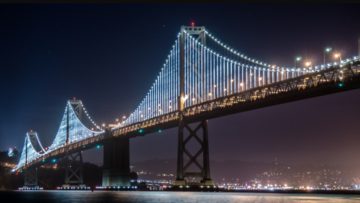
Originally published in the Marina Times San Francisco in June 2022
Public art in San Francisco: Preserving the past and paving the way toward the future
by Sharon Anderson
San Francisco, since its early days as a major seaport, has become a global arts and entertainment capital in part because of its long-term commitment to the arts. Walking through San Francisco tells the story of a city committed to art in public spaces. On the Embarcadero, a 70-foot partial bow and piece of an arrow — Cupid’s Span by Claus Oldenburg — is a whimsical pop art monument to a weapon of love. At Broadway and Columbus Avenue in North Beach, books hover in the air mimicking birds in motion in Brian Goggin and Dorka Keehn’s Language of the Birds. Passersby will notice on the plaza floor words are embedded that appear to have fallen from the pages above. Along the Bay Area Ridge Trail, hikers can witness a 100-foot collection of cypress tree trunks fastened together, titled Spire by environmental artist Andrew Goldsworthy.
PERMANENT PUBLIC ART
San Francisco’s earliest art policies date to 1932 when the Arts Commission was established, providing it jurisdiction over all the city-owned art and its preservation. Later, The Art Enrichment Ordinance was established in 1969 to provide a guaranteed funding mechanism for the acquisition of art for new public facilities and civic spaces. The ordinance ensures that 2 percent of gross construction cost of civic buildings, transportation improvement projects, new parks, and other above-ground structures be allocated for public art. Public art on private property is required to be generally accessible to the public.
The city also has a “1 percent for art program” requiring large construction projects to provide public art that equals at least 1 percent of the total construction cost. Some projects may choose to dedicate a portion of their 1 percent to the city’s Public Art Trust, which can be used for various purposes, including restoring artworks in the Civic Art Collection (kiosk.sfartscommission.org), which includes more than 4,000 historic monuments, memorials, and gifts to the city, valued at over $90 million.
PRESERVING SAN FRANCISCO’S CULTURAL HISTORY
Most recently, the San Francisco Art Institute received a $200,000 grant from the Mellon Foundation to support its monumental Diego Rivera fresco, The Making of a Fresco Showing the Building of a City. Commissioned by SFAI and later painted in 1931 during the artist’s first visit to the United States, Rivera’s muralis one of San Francisco’s most enduring and beloved cultural assets. The fresco occupies the north wall of the Diego Rivera Gallery on SFAI’s landmark campus at 800 Chestnut Street and is open to the public free of charge Monday through Saturday, 8 a.m. to 6 p.m.
INTEGRATING ART INTO DAILY LIFE
San Francisco continues its journey to integrate and preserve public artwork into the fabric of daily life to promote a diverse and stimulating cultural environment.
Yerba Buena Gardens, two blocks of public parks situated between Third, Fourth, Mission, and Folsom streets (and currently hosting free entertainment through Oct. 2; ybgfestival.org), contains many public art installations. Among these are the impressive Martin Luther King Jr. Memorial and Fountain, flanked by the Memorial Silver Walls designed by Dutch artist Lin Utzon in fissured granite, which reflect changes in the weather and sky; the Sister Cities Garden, with plants representing each of San Francisco’s sister cities along with a beautiful view of the downtown skyline; the Glass Green Ship, an 18-foot sculpture by John Roloff with portholes providing a glimpse into Moscone Center below; Brendon Monroe’s Roll, a mural inspired by water and air and resembling fog rolling over the city’s mountains; Keith Haring’s Three Dancing Figures | Untitled, an enamel on aluminum and concrete primary color sculpture on the corner of Howard and Third streets; and many more, including a tribute to the Ohlone American Indians whose tribes inhabited the Northern California coast. The art in the gardens is accessible daily, 6 a.m. to 10 p.m.
Perhaps the most visible public art is one on display daily from dusk to midnight: Leo Villareal’s, The Bay Lights. This spectacular light sculpture and generative art installation on the Bay Bridge consists of 25,000 individual white LED lights on the suspension cables and stretching the entire western span of the bridge, reminding us daily that San Francisco is a city that knows how to provide its residents and visitors with an enhanced environment.